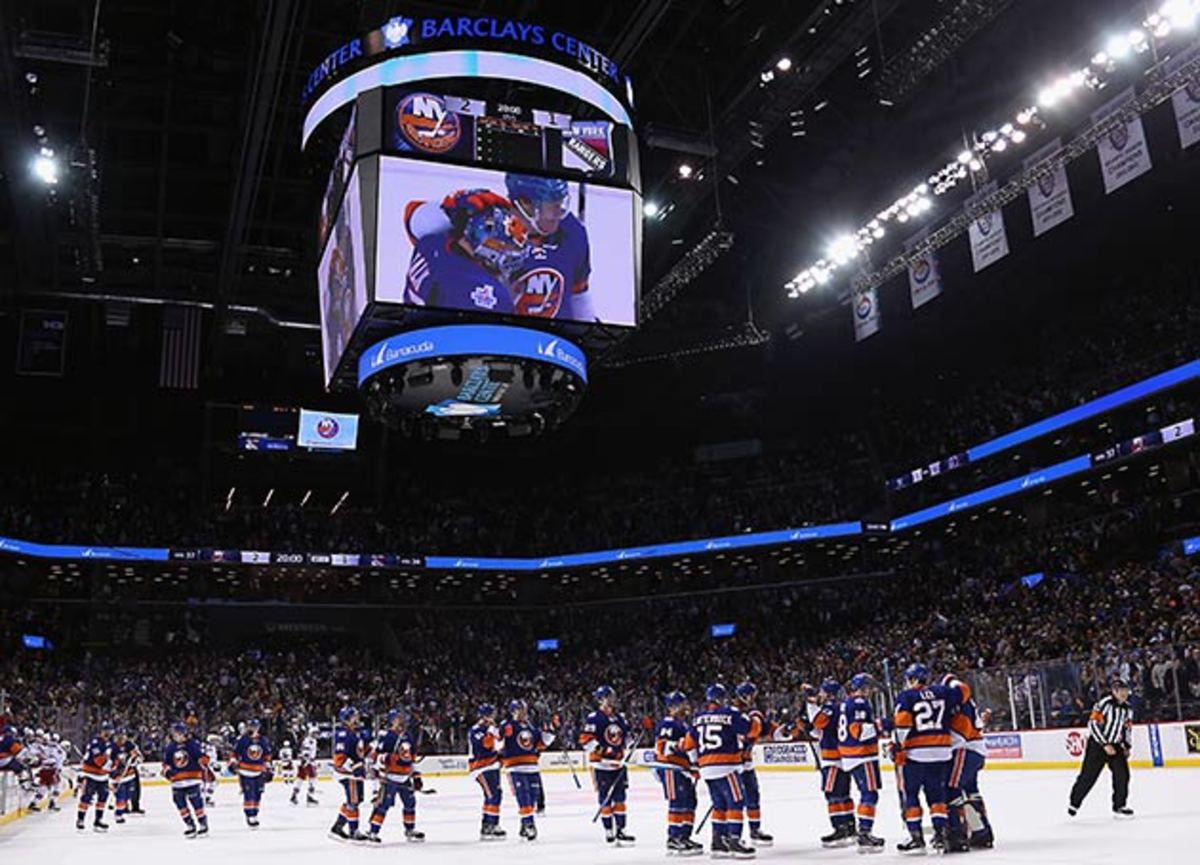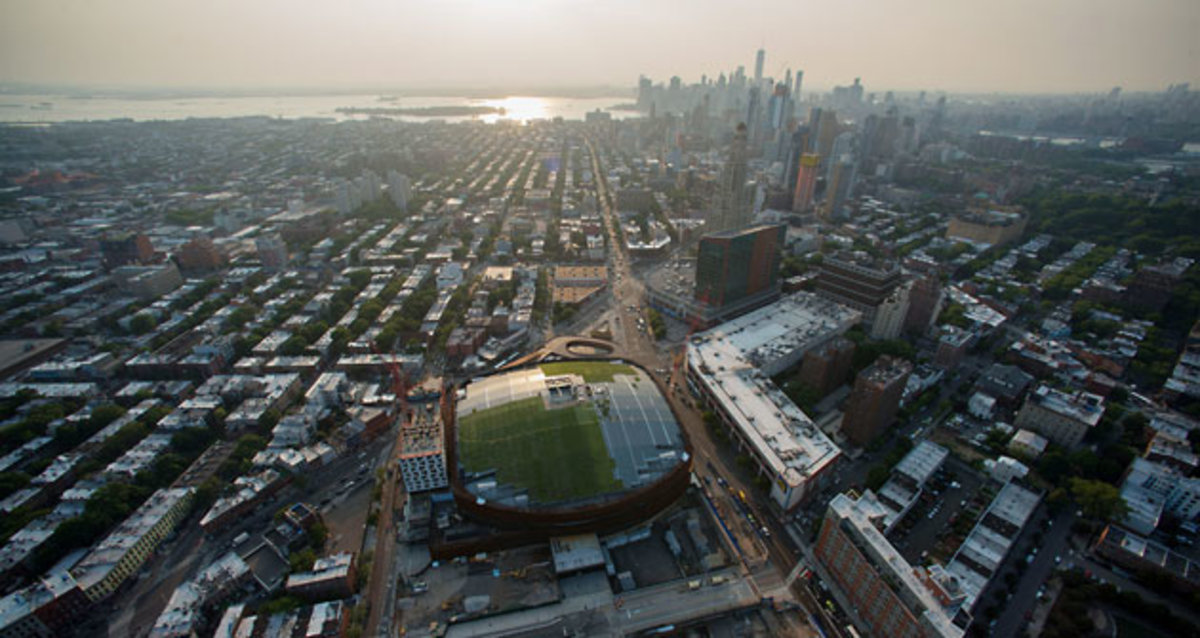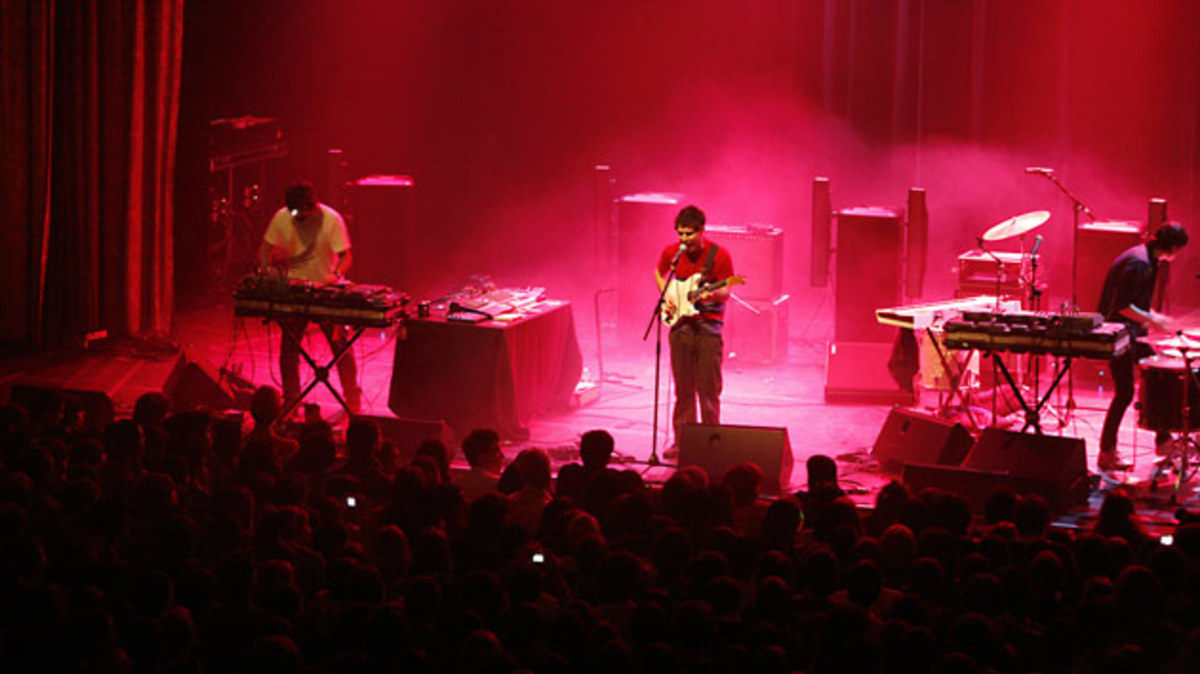Brooklyn can bring special noise to Rangers-Islanders rivalry

Brian Weitz, aka Geologist, is a founding member of the band Animal Collective and an avid hockey fan. This is his second piece for SI.com.
On December 2, 2015, I attended my first game at Barclays Center in Brooklyn. The home-ice Islanders won in a shootout following a 3-on-3 overtime period—a new facet of the game I enjoy so much that I almost don’t mind if the team I’m rooting for blows a late lead. I loved the game, but not because of any sincere interest in the Islanders’ success. Despite living in New York City during college in the late 1990s and spending significant time there over the last 15 years while it served as my band Animal Collective’s de facto headquarters, I am by no means a New York sports fan.
A Philadelphia Flyers fan, I’ve actually actively disliked the Islanders for most of my life. I was too young to experience and remember their dynasty of the 1980s. But I know the Islanders won the first of their four consecutive Stanley Cups against the Flyers. And to this day, it bugs me knowing former Islander Billy Smith—and not the Flyers' Ron Hextall—was the first NHL goalie to be credited with scoring a goal. During a game in November '79, Smith just happened to be the last Islander to touch the puck before Rob Ramage of the Colorado Rockies accidentally sent it the length of the ice and into his own team's net. Hextall, who actually scored a goal eight years later, will always be the first in my mind.
But for a long time after their dynasty had fallen, the Islanders were consistently bad, easy to poke fun at. Not only did they have a con man owner (John Spano), they fussed with a classic logo, adopting an unattractive image of a fisherman with colors you knew weren’t going to survive the ’90s, at least not in pro sports. To be fair, I might have seen an Animal Collective bandmate wearing those colors recently—and though the Flyers’ orange is a distinct shade of 1970—I still feel okay throwing stones from where I sit.
GALLERIES: Islanders Follies | NHL's 10 Best Rivalries
There has just always been something that leads me to dismiss the Islanders as irrelevant while ignoring their four Stanley Cups to Philadelphia’s two and the fact that they currently sit above the Flyers in the standings. Something that makes them feel like a second-tier team. Well, that something is the New York Rangers, their foes on that night in December and the reason I was so eager to go see the game to begin with. It was the first Rangers-Islanders meeting in Brooklyn; the first inter-borough game on the Islanders’ new home ice, just across the East River from the Rangers' home at storied Madison Square Garden.

Now, let’s be clear: Flyers fans dislike the Rangers even more than the Islanders. For a while you could chant “1940!” at the Rangers, reminding them it had been more than 50 years since they had won the Stanley Cup, but their championship in 1994 ended that fun. And as if that weren’t enough, the goalie backstopping that Rangers team was Mike Richter, who grew up idolizing Bernie Parent in Flourtown, PA—five miles from my childhood home!
Still, I wouldn’t ever dismiss or look down on the Rangers. They are a classic Original Six franchise still playing in one of the classic sports venues of the world. I’ll admit to having a little respect. And this is why I can’t even imagine how the Islanders organization and fan base feel about the Rangers in the post-1983 NHL landscape. No matter what they do, the Isles always seem to play second fiddle. Even as I write this, I can only think of the game I saw as “Rangers-Islanders.” My mind can’t put the Islanders first. They can’t contend with the history that makes the Rangers feel like one of the classic New York sports teams.
But at least until last year the Islanders used to be able to claim Long Island as their own. Now they share the same city with the Rangers, and are trying to establish an identity as Brooklyn’s team.
[youtube:https://youtu.be/qNYpHkFeVH0]
I’ve spent a lot of time in Brooklyn over the last 17 years, but it was almost always music that brought me there. It was never hockey, or any sports for that matter, so I was curious and excited to see how the new home is working out for the Islanders. Barclays Center, in the Flatbush neighborhood, is not far from Animal Collective’s first group house off the Atlantic Ave. exit of the BQE, where members of the band lived and recorded music 16 years ago. I’ve heard some mixed reviews of hockey at the venue; for example, it is obvious the arena was primarily designed for other uses, the 200-by-85 foot rink doesn’t really fit the smaller footprint of the floor, and visiting goalies have to get used to all the black seats and infrastructure when they’re trying to track that little black puck. These shortcomings were evident to me as soon as I sat down in my seat, but they didn’t bother me to the point that I couldn’t enjoy the game.
Islanders tackling many challenges during first season in Brooklyn
The biggest unanswered question at the season’s start was whether or not the fan base would follow the team from Long Island to Brooklyn. As of now, it doesn’t seem like they have, and many fans have been vocally disparaging of the new home. The Islanders rank 28th in the league in home attendance, ahead of only the Arizona Coyotes and Carolina Hurricanes, despite the fact that they have qualified for the playoffs for the second season in a row. The game I saw was sold out, but not because Islanders fans bought up all the tickets. I imagine at any Rangers-Islanders game, there are fans from both sides in the stands, but I would expect the home team to have the higher proportion. I don’t have definitive stats, but this game felt like a solid 50/50 split: half Rangers fans, half Islanders fans.
My strongest memory from the game wasn’t the John Tavares second-period power play goal, nor the equalizer that Rangers winger Viktor Stalberg deflected in six minutes later. It wasn’t what happened on the ice. It was the noise of the crowd—in the arena, outside the arena, and on the subway to and from the game. Most sports chants don’t vary much from one another, and from my limited experience, it seems the Rangers fans and Islanders fans both use the format of “Let’s go [insert team name]!” So at this game, you had 15,000 people screaming “Let’s go…” in unison, but half the crowd yelled “Rangers” while the other half hollered “Islanders.” The last word came out sounding like nothing except loud, unintelligible noise. The subway platform after the game was no different, and the noise continued onto the platform and into the train cars. To me, it sounded amazing.

Noise and New York City are inextricably linked for me. Aside from the obvious connection to the city’s constant din, my move to New York in the late 1990s coincided with my discovery of noise music, a genre that highlights dissonance, ambience, and texture more than traditional musical components like melody and rhythm. I saw noise bands play at clubs like The Cooler, Knitting Factory and Tonic, and I hosted a weekly music show on college radio from 1 a.m. to 5 a.m., which was one of the only possible time slots I’d be allowed to play some of the harshest noise music in the station’s collection.
In the fall of 2000, Animal Collective got its first practice space in Brooklyn and started to release records and play shows. I was attending college in Manhattan at the time, and actually most of the clubs we played were there too, but we were considered part of a new scene associated more with Brooklyn. A lot of the bands in this scene didn’t sound anything like one another, and there wasn’t really a catch-all genre we fit into, but I remember the word “noise.” We even used it ourselves for lack of a better term, and it’d be stuck in front of another, more accessible genre: “noise rock,” “noise pop,” or sometimes something more loaded, like “experimental.”
Experimental and noise music was not new in New York City at the time; it has a long history there with many subsets, icons and classic records going back decades. Admittedly a lot of it sounds the same from one era to the next, and it’s a slippery slope between inspiration and direct replication, but we felt the bands in our circle were trying to achieve something new and unique without referencing our influences too much. It was always for others to decide if we were successful, but we tried nonetheless.
Past, present collide for Red Wings-Avs in Stadium Series
The fall of 2000 was also a time when people started talking about a new retro rock and roll scene in New York. I remember playing a club called the Mercury Lounge around that time and hearing about another good band that often played there. I hadn’t heard their music yet, but their name and style suggested a kind of retro ’70s rock and roll, and I wasn’t compelled to check them out. I assumed their sound would be something too classic NYC for my taste, even though I loved and respected some of that music. I was listening to Television’s Marquee Moon on a regular basis back then, and you could trace some of Animal Collective’s ideas back to things the Velvet Underground were exploring in the ’60s. We were by no means against the history of underground rock music in New York City.
But we always thought that we should carry on the spirit of those bands more than the sound. In their own time they were new-sounding and forward thinking. To be truly influenced by them and part of their tradition, I thought, a modern band should find its own sound. Now that I’m in my mid-30s my stance on that has softened somewhat, but I was 21 then, and I thought more like a sports fan whose allegiances and behaviors had been cemented in place during grade school. I was on one team, and the nostalgic CBGB’s romantics were on another.
That was a mistake, because that other band I'd heard about at the Mercury Lounge was The Strokes. I heard their first record a short time later and loved it. I liked them even more when their second record came out. I’ve since seen them play in front of thousands of people, but skipping their early shows in New York City in 2000 is a big regret of mine from that era (along with never playing CBGB’s before it closed, ironically). And there was no good reason for it.
The New York music scene always has room for something classic and something new, and it often sounds best when they combine. Some of the most essential New York City bands are the ones who were open to combining the traditional with the innovative. In the 1970s The Ramones took the new energy of punk rock and applied it to the already classic sound of Phil Spector-produced girl group music from the previous decade. In the ’80s, two iconic New York groups—Sonic Youth in Manhattan and Public Enemy on Long Island—set themselves apart from many of their peers by using experimental guitar and turntable techniques to add dense layers of noise to their music, yet still managed to keep a foot firmly in their overarching genres of rock and hip hop, respectively.

Likewise, I want to keep hearing the noise of the classic and the new in New York City’s hockey market. It might be too early to say whether or not there is room for two hockey teams within the city limits, but I sincerely hope there is. It’s worked for the other three major sports, especially in baseball. In fact, another thing I won’t forget about the fall of 2000 in addition to missing out on The Strokes is the World (Subway) Series between the Yankees and the Mets. It was incredibly fun to be around that energy in the city. I went to a party for every game, and my friends and I didn’t even like baseball all that much. I didn’t care which team won; I just cared that it was happening and that I was in New York for the ride.
But the Yankees and Mets haven’t played each other in the World Series since. The Giants and the Jets have never met in the Super Bowl. In fact none of those teams in either sport can ever play each other in a meaningful playoff series unless they both make it to the championship. And the odds of that happening frequently are slim. The Rangers and Islanders, on the other hand, play in the same division. In addition to four regular season games in the city every year, all of which will have an impact on both teams’ postseason prospects, there will always be a chance of the Rangers and Islanders meeting in any of the first three rounds of the Stanley Cup playoffs. That would create a lot of noise in the subways, bars and arenas.
Pelle Lindbergh’s tragic death raises tough questions 30 years later
Right now there is still some ground to cover. The Islanders need more of a fan base inside New York City. I don’t mean to forget about their fans out on Long Island or dismiss what they’ve lost. I can’t imagine what it feels like to lose your local team. I remember hearing rumors in the late 1980s that the Flyers might build a new arena in Camden, N.J., and I couldn’t handle it. Like the Giants and Jets playing in New Jersey under the banner of New York, the Flyers would still be Philadelphia's, but the very idea that the team would technically play in New Jersey, only a few minutes from where they play now in South Philly, made them feel less like my home team.
So I can understand it if the long-time Isles fans don’t follow the team to Brooklyn. Logistics alone probably prevent some from making the frequent commute. But if they can’t fill the entirety of Barclays Center with the old fans, I hope the Isles find new ones in Brooklyn. Maybe hockey doesn’t look great at Barclays right now, just like images of The Strokes didn’t look great to me in 2000. Don’t repeat my mistake. Based on the noise I heard this past December, I do think there is room for two teams in the city. The Rangers are the classic franchise of old New York, and the Islanders are the new blood. New York has always felt best when both are there.
